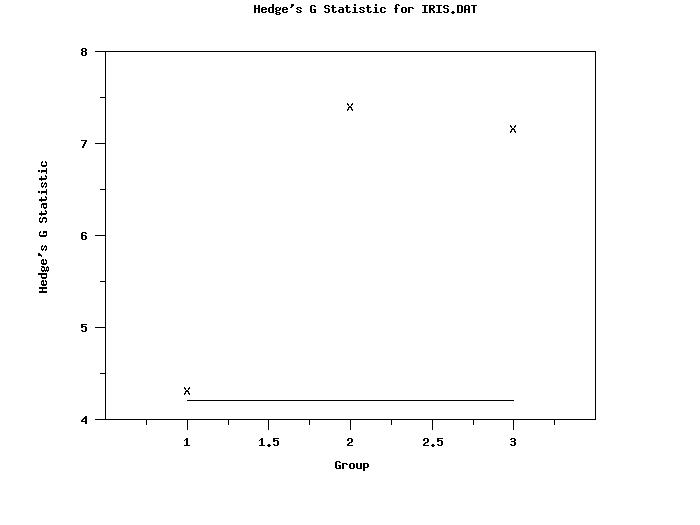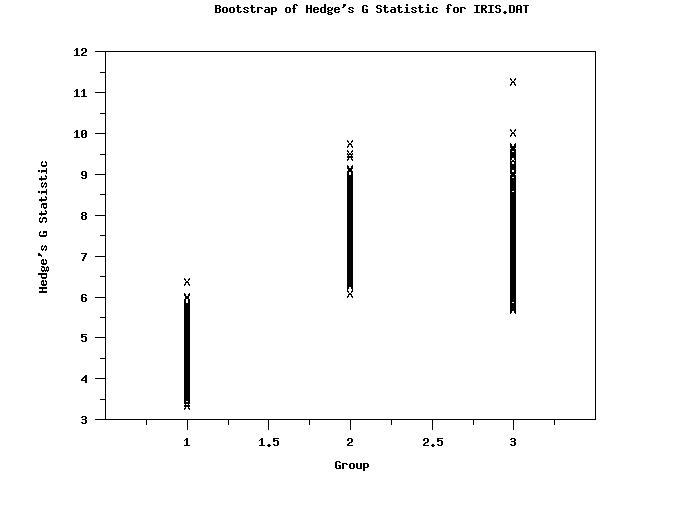

|
HEDGES GName:
BIAS CORRECTED HEDGES G (LET) COHENS D (LET) GLASS G (LET)
with \( \bar{y}_{1} \), \( \bar{y}_{2} \), and \( s_{p} \) denoting the mean of sample 1, the mean of sample 2, and the pooled standard deviation, respectively. The formula for the pooled standard deviation is
with \( s_{1} \) and \( n_{1} \) denoting the standard deviation and number of observations for sample 1, respectively, and \( s_{2} \) and \( n_{2} \) denoting the standard deviation and number of observations for sample 2, respectively. The Hedge's g statistic expresses the difference of the means in units of the pooled standard deviation. For small samples, the following bias correction is recommended
where \( n = n_{1} + n_{2} \). This bias correction is typically recommended when n < 50. NOTE:
The term being approximated is
where
with \( \Gamma \) denoting the Gamma function. Running a comparison indicated that Hedge's original approximation is more accurate than that given by Durlak. The 2018/08 version of Dataplot modified the bias correction to use the original J function with Gamma functions for \( n_1 + n_2 \le 40 \) and to use Hedge's original approximation otherwise. Hedge's g is similar to the Cohen's d statistic and the Glass g statistic. The difference is what is used for the estimate of the pooled standard deviation. The Hedge's g uses a sample size weighted pooled standard deviation while Cohen's d uses
These statistic are typically used to compare an experimental sample to a control sample. The Glass g statistic uses the standard deviation of the control sample rather than the pooled standard deviation. His argument for this is that experimental samples with very different standard deviations can result in significant differences in the g statistic for equivalent differences in the mean. So the Glass g statistic measures the difference in means in units of the control sample standard deviation. Hedge's g, Cohen's d, and Glass's g are interpreted in the same way. Cohen recommended the following rule of thumb
However, Cohen did suggest caution for this rule of thumb as the meaning of small, medium and large may vary depending on the context of a particular study. The Hedge's g statistic is generally preferred to Cohen's d statistic. It has better small sample properties and has better properties when the sample sizes are signigicantly different. For large samples where \( n_{1} \) and \( n_{2} \) are similar, the two statistics should be almost the same. The Glass g statistic may be preferred when the standard deviations are quite different. In many cases, there are multiple experimental groups being compared to the control. This could be either a separate control sample for each experiment (e.g., we are comparing effect sizes from different experiments) or a common control (e.g., different laboratories are measuring identical material and are being compared to a reference measurement). In these cases, you can compute the Hedge's g (or Glass's g or Cohen's d) for each experiment relative to its control group. You can then obtain an "overall" value of the statistic by averaging these individual statistics.
<SUBSET/EXCEPT/FOR qualification> where <y1> is the first response variable; <y2> is the second response variable; <par> is a parameter where the computed Hedge's g statistic is stored; and where the <SUBSET/EXCEPT/FOR qualification> is optional. This syntax computes Hedge's g statistic without the bias correction.
<SUBSET/EXCEPT/FOR qualification> where <y1> is the first response variable; <y2> is the second response variable; <par> is a parameter where the computed bias corrected Hedge's g statistic is stored; and where the <SUBSET/EXCEPT/FOR qualification> is optional. This syntax computes the Hedge's g statistic with the bias correction.
<SUBSET/EXCEPT/FOR qualification> where <y1> is the first response variable; <y2> is the second response variable; <par> is a parameter where the computed Glass's g statistic is stored; and where the <SUBSET/EXCEPT/FOR qualification> is optional. This syntax computes Glass's g statistic. The <y2> variable will be treated as the "control" sample. That is, the standard deviation of <y2> will be used as the pooled standard deviation.
<SUBSET/EXCEPT/FOR qualification> where <y1> is the first response variable; <y2> is the second response variable; <par> is a parameter where the computed Cohen's d statistic is stored; and where the <SUBSET/EXCEPT/FOR qualification> is optional. This syntax computes Cohen's d statistic.
LET A = BIAS CORRECTED HEDGES G Y1 Y2 LET A = BIAS CORRECTED HEDGES G Y1 Y2 SUBSET Y1 > 0 LET A = GLASS G Y1 Y2 LET A = COHENS D Y1 Y2
Cohen (1977), "Statistical Power Analysis for the Behavioral Sciences", Routledge. Glass (1976), "Primary, Secondary, and Meta-Analysis of Research", Educational Researcher, Vol. 5, pp. 3-8. Durlak (2009), "How to Select, Calculate, and Interpret Effect Sizes", Journal of Pediatric Psychology, Vol. 34, No. 9, pp. 917-928. Hedges and Olkin (1985), "Statistical Methods for Meta-Analysis", New York: Academic Press.
SKIP 25
READ IRIS.DAT Y1 TO Y4 X
.
LET A = HEDGES G Y1 Y2
TABULATE HEDGES G Y1 Y2 X
.
LABEL CASE ASIS
TITLE CASE ASIS
Y1LABEL Hedge's G Statistic
X1LABEL Group
TITLE Hedge's G Statistic for IRIS.DAT
X1TIC MARK OFFSET 0.5 0.5
TIC MARK OFFSET UNITS DATA
CHAR X
LINE BLANK
HEDGES G PLOT Y1 Y2 X
.
Y1LABEL Hedge's G Statistic
X1LABEL Group
TITLE Bootstrap of Hedge's G Statistic for IRIS.DAT
CHAR X ALL
LINE BLANK ALL
BOOTSTRAP SAMPLES 1000
BOOTSTRAP HEDGES G PLOT Y1 Y2 X
The following output is generated
Cross Tabulate HEDGES G
(Response Variables: Y1 Y2 )
---------------------------------------------
X | HEDGES G
---------------------------------------------
0.1000000E+01 | 0.4311260E+01
0.2000000E+01 | 0.7412040E+01
0.3000000E+01 | 0.7168413E+01

Bootstrap Analysis for the HEDGES G
Response Variable One: Y1
Response Variable Two: Y2
Group ID Variable One (X ): 1.000000
Number of Bootstrap Samples: 1000
Number of Observations: 50
Mean of Bootstrap Samples: 4.389604
Standard Deviation of Bootstrap Samples: 0.4288846
Median of Bootstrap Samples: 4.335823
MAD of Bootstrap Samples: 0.2615915
Minimum of Bootstrap Samples: 3.342993
Maximum of Bootstrap Samples: 6.389001
Percent Points of the Bootstrap Samples
-----------------------------------
Percent Point Value
-----------------------------------
0.1 = 3.343002
0.5 = 3.511410
1.0 = 3.546756
2.5 = 3.687836
5.0 = 3.798257
10.0 = 3.910058
20.0 = 4.037920
50.0 = 4.335823
80.0 = 4.705708
90.0 = 4.947669
95.0 = 5.174219
97.5 = 5.409715
99.0 = 5.681841
99.5 = 5.823756
99.9 = 6.388623
Percentile Confidence Interval for Statistic
------------------------------------------
Confidence Lower Upper
Coefficient Limit Limit
------------------------------------------
50.00 4.087805 4.619201
75.00 3.934208 4.869211
90.00 3.798257 5.174219
95.00 3.687836 5.409715
99.00 3.511410 5.823756
99.90 3.342993 6.389001
------------------------------------------
Response Variable One: Y1
Response Variable Two: Y2
Group ID Variable One (X ): 2.000000
Number of Bootstrap Samples: 1000
Number of Observations: 50
Mean of Bootstrap Samples: 7.537408
Standard Deviation of Bootstrap Samples: 0.5465833
Median of Bootstrap Samples: 7.499111
MAD of Bootstrap Samples: 0.3508403
Minimum of Bootstrap Samples: 6.092766
Maximum of Bootstrap Samples: 9.751977
Percent Points of the Bootstrap Samples
-----------------------------------
Percent Point Value
-----------------------------------
0.1 = 6.092945
0.5 = 6.287894
1.0 = 6.397113
2.5 = 6.541644
5.0 = 6.668351
10.0 = 6.842498
20.0 = 7.102805
50.0 = 7.499111
80.0 = 7.976231
90.0 = 8.257037
95.0 = 8.490531
97.5 = 8.726730
99.0 = 8.898412
99.5 = 9.116481
99.9 = 9.751736
Percentile Confidence Interval for Statistic
------------------------------------------
Confidence Lower Upper
Coefficient Limit Limit
------------------------------------------
50.00 7.171687 7.894311
75.00 6.920084 8.177537
90.00 6.668351 8.490531
95.00 6.541644 8.726730
99.00 6.287894 9.116481
99.90 6.092766 9.751977
------------------------------------------
Response Variable One: Y1
Response Variable Two: Y2
Group ID Variable One (X ): 3.000000
Number of Bootstrap Samples: 1000
Number of Observations: 50
Mean of Bootstrap Samples: 7.338842
Standard Deviation of Bootstrap Samples: 0.6960418
Median of Bootstrap Samples: 7.310299
MAD of Bootstrap Samples: 0.4584347
Minimum of Bootstrap Samples: 5.688356
Maximum of Bootstrap Samples: 11.27284
Percent Points of the Bootstrap Samples
-----------------------------------
Percent Point Value
-----------------------------------
0.1 = 5.688367
0.5 = 5.747268
1.0 = 5.929775
2.5 = 6.122410
5.0 = 6.271287
10.0 = 6.488546
20.0 = 6.749534
50.0 = 7.310299
80.0 = 7.873042
90.0 = 8.208357
95.0 = 8.487544
97.5 = 8.823580
99.0 = 9.252583
99.5 = 9.609171
99.9 = 11.27161
Percentile Confidence Interval for Statistic
------------------------------------------
Confidence Lower Upper
Coefficient Limit Limit
------------------------------------------
50.00 6.862967 7.771134
75.00 6.543979 8.090032
90.00 6.271287 8.487544
95.00 6.122410 8.823580
99.00 5.747268 9.609171
99.90 5.688356 11.27284
------------------------------------------
Response Variable One: Y1
Response Variable Two: Y2
Group ID Variable One (All Data):
Number of Bootstrap Samples: 1000
Number of Observations: 150
Mean of Bootstrap Samples: 6.421951
Standard Deviation of Bootstrap Samples: 1.547468
Median of Bootstrap Samples: 7.007179
MAD of Bootstrap Samples: 0.8567694
Minimum of Bootstrap Samples: 3.342993
Maximum of Bootstrap Samples: 11.27284
Percent Points of the Bootstrap Samples
-----------------------------------
Percent Point Value
-----------------------------------
0.1 = 3.409331
0.5 = 3.625963
1.0 = 3.741478
2.5 = 3.852497
5.0 = 3.968823
10.0 = 4.131668
20.0 = 4.447991
50.0 = 7.007179
80.0 = 7.739732
90.0 = 8.062719
95.0 = 8.351421
97.5 = 8.614502
99.0 = 8.894499
99.5 = 9.203490
99.9 = 9.751902
Percentile Confidence Interval for Statistic
------------------------------------------
Confidence Lower Upper
Coefficient Limit Limit
------------------------------------------
50.00 4.617406 7.610766
75.00 4.210556 7.962787
90.00 3.968823 8.351421
95.00 3.852497 8.614502
99.00 3.625963 9.203490
99.90 3.347339 10.65474
------------------------------------------

|
Privacy
Policy/Security Notice
NIST is an agency of the U.S.
Commerce Department.
Date created: 07/26/2017 | |||||||||||||||||||||||||||||||